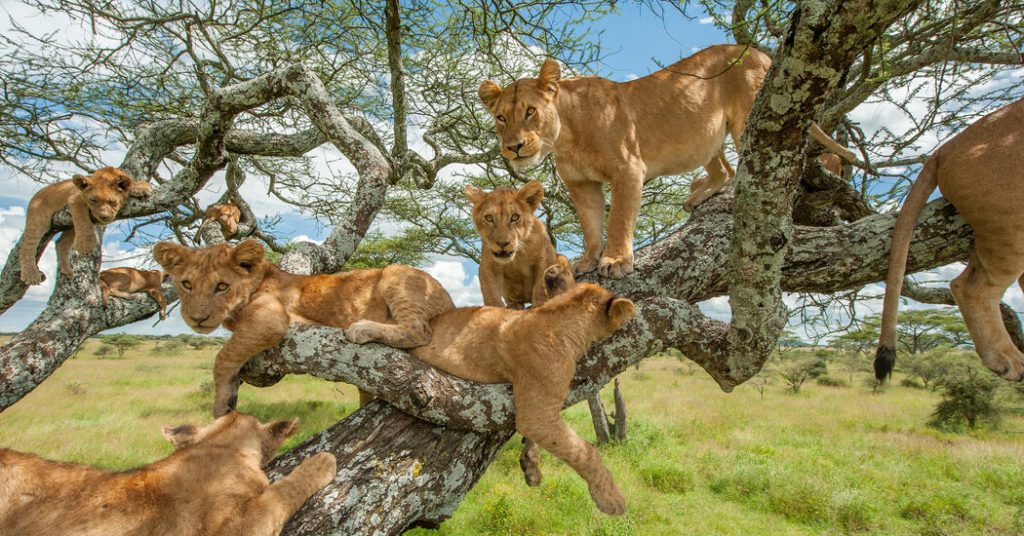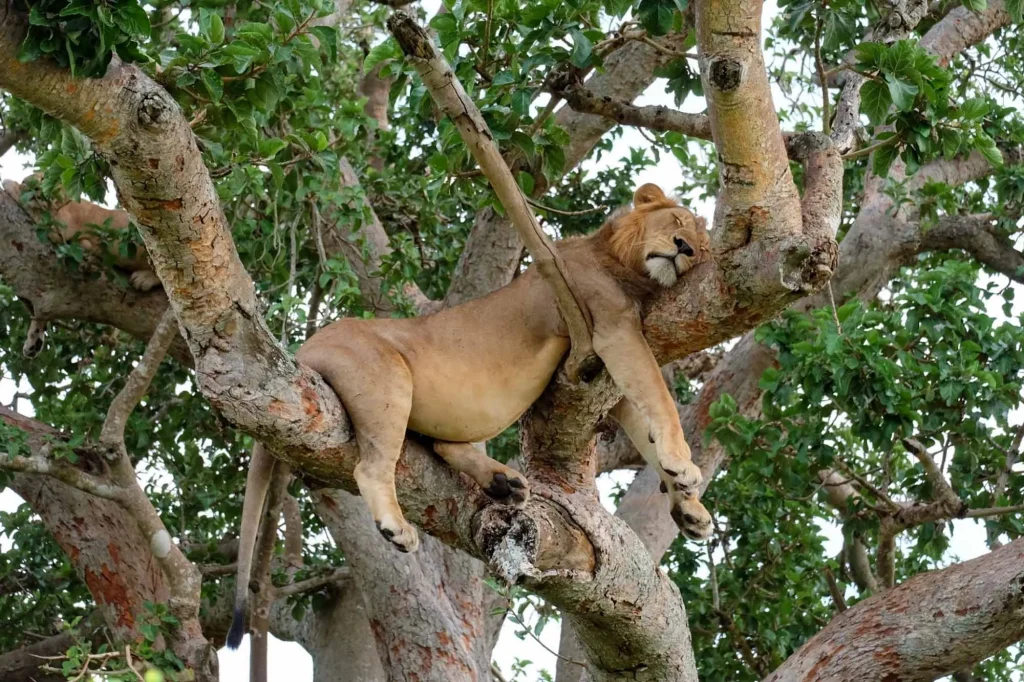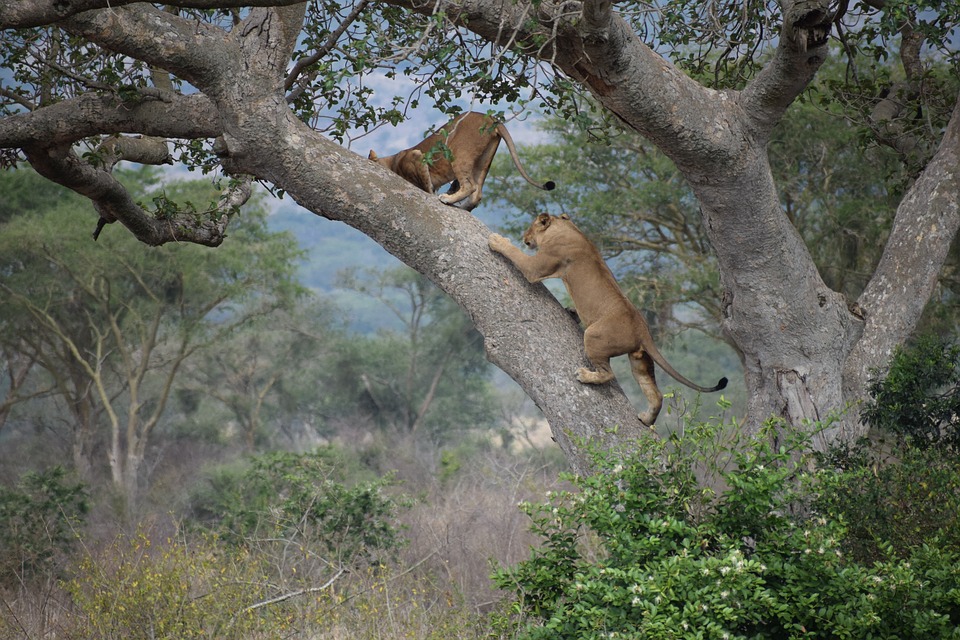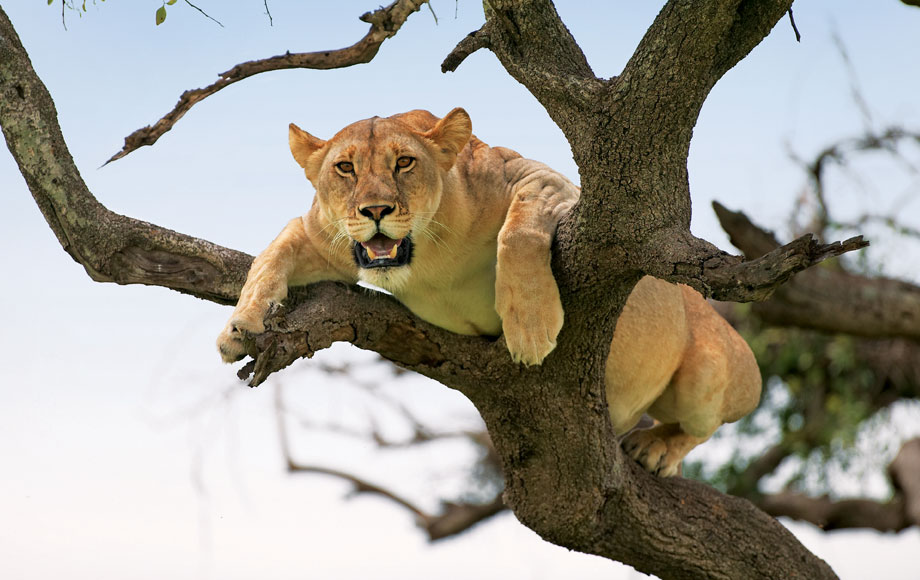Lake Manyara’s Iconic Tree-Climbing Lions




Introduction
Lake Manyara National Park is known for its breathtaking scenery, rich wildlife, and especially for its unique population of tree-climbing lions. These lions, distinct from other lion populations in Africa, have adapted a remarkable behavior of climbing and resting in trees, offering a rare spectacle that draws nature lovers and wildlife photographers from around the world. Here’s everything you need to know about the fascinating Lake Manyara tree-climbing lions and why a safari to see them is an unmissable experience in Tanzania.
Why Lake Manyara’s Lions Climb Trees
Unlike most lions, which are typically found on the ground, lions in Lake Manyara National Park are frequently seen lounging in trees. While there is no definitive explanation for this behavior, several theories suggest reasons for their tree-climbing habit:
- Escaping Pests: Tsetse flies and other biting insects are common in Lake Manyara. By climbing trees, lions may be able to avoid these irritants and enjoy a more comfortable resting spot above the ground.
- Cooling Off: Lake Manyara’s climate can be hot, and tree branches offer a cool, shaded refuge. Elevated positions often have a breeze, making it more comfortable for lions to rest in the heat of the day.
- Observational Advantage: From the vantage point of tree branches, lions can survey their surroundings, potentially spotting prey or watching out for other animals. This heightened perspective may help them strategize or simply rest more comfortably, knowing they have a good view of the area.
- Learned Behavior: Some wildlife experts believe that tree-climbing could be a learned behavior, passed down through generations. Young lions often mimic the actions of adults, and over time, this behavior could become a regular part of the lions’ lives in Lake Manyara.
Unique Characteristics of Lake Manyara’s Tree-Climbing Lions
These tree-climbing lions are typically seen resting on the sturdy branches of acacia and sycamore fig trees. Unlike leopards, which are natural climbers with powerful limbs, lions are not as well-adapted for tree climbing. This makes their ascent to the trees even more surprising and impressive. Once in the branches, the lions often lounge in relaxed positions, draped over the limbs or nestled against the trunk, which makes for unique and memorable photo opportunities.
Tree-climbing lions in Lake Manyara often exhibit a relaxed demeanor, making them a fascinating subject for visitors who come to see this rare and unusual behavior up close.
The Best Time and Place to Spot Tree-Climbing Lions
If you’re planning a trip to see Lake Manyara’s tree-climbing lions, understanding the best times and places for spotting them can help make the experience even more rewarding.
- Season: While tree-climbing lions can be spotted throughout the year, the dry season (June to October) is an excellent time to visit Lake Manyara, as wildlife congregates around water sources, and foliage is less dense, making lions easier to spot.
- Areas within the Park: Tree-climbing lions are often seen in the southern parts of Lake Manyara National Park, where large acacia and fig trees provide ample space for resting. The area around the park’s central plains and the lake’s edges are also common places to spot these lions in the trees.
- Time of Day: Early mornings and late afternoons are ideal times for spotting lions, as they are more likely to be active during these cooler hours. During the hottest parts of the day, the lions are more likely to be resting in the trees, taking advantage of the shaded branches to cool off.
How to Experience Lake Manyara’s Tree-Climbing Lions
Lake Manyara National Park offers a variety of safari options to help visitors experience its tree-climbing lions and other wildlife.
- Game Drives: A traditional game drive through Lake Manyara National Park allows visitors to get close to the tree-climbing lions. Guides who know the park well can take visitors to areas where the lions are most frequently seen, maximizing the chances of witnessing this unique behavior.
- Photography Tours: For wildlife photographers, specialized tours focus on capturing Lake Manyara’s unique tree-climbing lions. These tours often include time in prime lion habitats and guidance from professional photographers to help visitors capture high-quality images of the lions in the trees.
- Guided Nature Walks: Some areas in and around Lake Manyara National Park offer guided nature walks. While tree-climbing lions are usually observed from vehicles for safety, these walks give visitors a closer perspective on the park’s ecosystem and a chance to learn more about the behavior and habitats of the lions.
- Night Drives: Although rare, night drives in certain areas around Lake Manyara can provide a unique view of nocturnal behaviors. While lions are usually resting in trees during the day, they may come down and hunt at night, offering another perspective on their activity.
Other Wildlife to See in Lake Manyara National Park
In addition to its famous tree-climbing lions, Lake Manyara National Park is home to a variety of other wildlife species:
- Elephants: Lake Manyara has a large elephant population, often seen grazing in the woodlands and around the lake.
- Buffalo and Giraffes: Both species are common in the park and can be seen along the lake’s edge and open plains.
- Baboons: Lake Manyara is famous for its dense baboon populations, often seen in large troops near the park’s entrance.
- Birdlife: Lake Manyara is a haven for birdwatchers, with over 400 bird species, including pelicans, storks, and flamingos.
Conservation Efforts for Lake Manyara’s Tree-Climbing Lions
While Lake Manyara’s lions have adapted to an unusual lifestyle, they still face conservation challenges:
- Human-Wildlife Conflict: As with many wildlife areas in Tanzania, Lake Manyara’s lions sometimes come into conflict with nearby human communities, particularly in cases where livestock grazing occurs near park boundaries. Conservation efforts focus on creating buffer zones and encouraging local communities to engage in conservation-friendly practices.
- Habitat Conservation: Protecting Lake Manyara’s delicate ecosystem is crucial for the continued health of its lion population. Efforts are underway to preserve the trees and habitats that the lions and other wildlife depend on, particularly in the face of climate change and environmental degradation.
- Community Engagement: Sustainable tourism initiatives, in collaboration with local communities, help raise awareness and provide economic benefits to local residents. By involving communities in conservation and promoting responsible tourism, the park helps ensure the continued presence of its unique lion population.
Planning a Safari to See Lake Manyara’s Tree-Climbing Lions
To make the most of a visit to see Lake Manyara’s tree-climbing lions, here are a few tips for planning your trip:
- Choose the Right Safari Package: Several safari packages include stops at Lake Manyara National Park, often combined with visits to other nearby parks like the Serengeti and Ngorongoro Crater. A well-planned itinerary allows visitors to see a variety of Tanzania’s unique wildlife.
- Pack Appropriate Gear: Bringing binoculars, a good camera, and clothing for various weather conditions will enhance your experience. The park’s diverse ecosystem offers opportunities for stunning photographs, especially of the lions resting in trees.
- Opt for Local Guides: Local guides are often well-versed in lion behavior and know where to find tree-climbing lions. Supporting local guides also contributes to the local economy and community-based conservation efforts.
- Respect Wildlife and Follow Park Guidelines: While viewing lions in trees is thrilling, it’s essential to respect their natural habitat and avoid behaviors that may disturb them. Adhering to park guidelines helps protect both visitors and the wildlife.
Why Lake Manyara’s Tree-Climbing Lions Are Unique
Seeing tree-climbing lions in Lake Manyara is a rare and unforgettable experience. It defies the typical image of lions as ground-dwelling animals and offers a unique glimpse into the adaptability of these majestic creatures. This unusual behavior has made Lake Manyara’s lions an icon of the park and a symbol of Tanzania’s incredible biodiversity. For travelers seeking a one-of-a-kind wildlife experience, Lake Manyara’s tree-climbing lions offer a memorable and meaningful encounter with nature.
Conclusion: An Unmissable Wildlife Adventure
Lake Manyara tree-climbing lions stand as one of Tanzania’s most extraordinary wildlife attractions. Observing these lions perched high in the trees against the beautiful backdrop of Lake Manyara and the Great Rift Valley is a sight that stays with visitors long after their safari ends. By exploring Lake Manyara, visitors not only witness a rare natural phenomenon but also contribute to conservation efforts that help protect this unique population and its habitat. For anyone planning an African safari, a visit to see the tree-climbing lions of Lake Manyara is an essential and truly exceptional experience.

One Comment